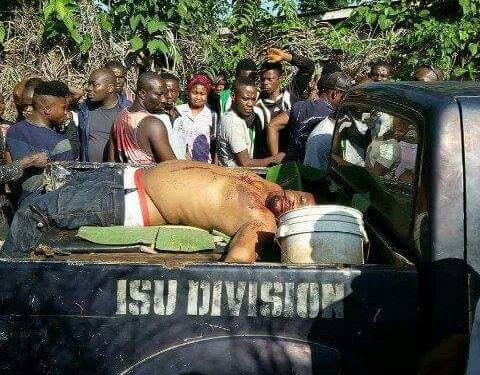After the slaying of pro-Biafra demonstrators in Onitsha, details of how the mass killing was coordinated by security forces has emerged.
PREMIUM TIMES has obtained an insider account by a whistleblower, who is an operative of the State Security Service.
The same whistleblower had reached out and provided vital information to two human rights organization, the Amnesty International and the Intersociety for Civil Liberties & Rule of Law.
Blowing the whistle
The operative, who was part of the security joint operation but is now disturbed by the manner soldiers “refused to play by the rule”, contacted a trusted human rights activist.
The identity of the whistleblower is being concealed so he is not punished by the authorities. His recorded narrative is however in the possession of this newspaper.
The whistleblower stated that the operation started with medium use of force on the night of May 29.
The following morning, the joint task force moved from the Onitsha Army Barracks to the rally venue on Nkpor-Umuoji Road only to find a crowd of pro-Biafra supporters who had been battered the night before by invading soldiers in the premises of St Edmunds Catholic Primary School.
The crowd, joined by newcomers, was by now in a resistance mood.
At that point the JTF retreated to Onitsha Military Barracks. The retreat infuriated Cantonment Commander, Issah M. Abdullahi, a colonel, who ordered them back to clear the venue and roads of all “miscreants.”
With this firm directive, the JTF, dominated by soldiers and led by Major C.O. Ibrahim of the Nigerian Military Police, stormed the streets and the event venue.
The rest is history. The whistleblower said that while other members of the JTF were minimizing the use of force, soldiers recklessly opened fire at crowds, shooting at close range, and “wasting people indiscriminately.”
Passersby and people in their homes and shops were not spared of stray bullets, the SSS operative said.
He said it got to a point where injured pro-Biafra supporters, seeing the countless bodies of their colleagues on the ground, opened their arms wide, advanced towards thesoldiers screaming that they too should be killed.
Three military trucks were used to cart away heaps of dead bodies.
According to the whistleblower, there are two cemeteries inside the Onitsha Army Barracks. Though reserved for fallen soldiers, victims of the massacre were buried in the cemetery close to Yahweh Church, inside the barracks.
The whistleblower added that in the evening of the same day when everyone thought the dust had settled, JTF operatives invaded the Nnewi Teaching Hospital and to the fury of nurses, abducted 12 gunshot victims and seven of their relations looking after them.
The 19, including women, were brought before the Commissioner of Police, Hosea Karma. He claimed that the commissioner accused the 19 of threatening the security of the state.
He would however order that the wounded men be returned to the hospital while their family members be taken away by SARS for interrogation. Human rights activists familiar with police tactics in Nigeria say that interrogation by SARS is a euphemism for torture.
Continuing his narrative, the whistleblower said that on June 2, two days after the massacre, soldiers stormed the Nnewi hospital and arrested eight of the 12 critical injured men the commissioner had earlier sent back to hospital.
Their whereabouts remain unknown.
PREMIUM TIMES separately gathered that on June 3, five men with serious bullet wounds were transferred by soldiers from Onitsha Army Barracks to the State CID and dumped inside a cell without any medical attention.
We are unable to ascertain if the five men were among the eight abducted from Nnewi Teaching Hospital the day before. The name of one of the abducted men is given as Ugoo K.C.
As the news spread that soldiers had invaded the Nnewi Teaching Hospital, gunshot victims in other hospitals begged their relations to move them to other states.
Among those moved to Abia State were Chidi Nwigwe, Uchenna Odaa, Ezeaka Ejike, Chima Anamuasonye, Nwaowe John, Ifeanyi C. Azubuike and Ugochukwu Nnamu. Those moved to Enugu included Ifeanyi Ogumma and Arinze Aja.
Since the whistleblower’s account, human rights groups have worked their contacts in the various security outfits to check out the story.
A security source, another SSS source and a military police source individually confirmed that a mass burial occurred in the afternoon of Wednesday, June 1 in a military cemetery, near Yahweh Church, inside the Onitsha Military Barracks.
The military police source added that a total of 15 graves were prepared with some taking as many as 10 bodies while some contained only five.
To hell and back: an escapee experience
‘To hell and back’ is the only way to summarize the experience of Henry Ibebuike Enekwe, the 32-year old electrical engineer who was abducted by soldiers on his way to Enugu.
News of Mr. Enekwe’s abduction was widely circulated by the human rights coalition called the Southeast Based Coalition of Human Rights Organizations.
Recounting his ordeal, Mr. Enekwe, who is not an IPOB member, said he was on his way to Enugu from Onitsha to seal an electrical-installation contract with a Lagos-based businessman. In the morning of the D-Day, May 30, 2016, he was abducted by soldiers and taken to the Onitsha Military Cantonment.
“I live at Nkpor-Agu. The greatest shock of my live was witnessing the killing of three young men returning from early-morning mass in front of the street leading to St Edmunds Catholic Church Nkpor-Agu (Early-morning mass is a daily ritual for Catholic communities). I was arrested and thrown inside a military truck. I think the three young men panicked when they saw the soldiers waving their guns and barking. They attempted to run and right before my very eyes, the soldiers fired at them one after the other. They picked up their corpses and threw them like logs of wood into the same truck I was sitting inside. The soldiers moved from that street to another, arresting people and throwing them inside the same truck and killing others and picking up their bodies. They were acting like hunters on a hunting expedition.”
Killing Biafra Protesters In Onitsha, This Is How It Went Down
0
Leave a Reply Cancel reply
BROWSE BY CATEGORIES
- #SmartLagos
- Basketball
- Beauty
- Boxing
- Breaking
- Business
- Careers
- Crime
- Default
- Education
- Entertainment
- Event
- Fashion
- Featured
- Football
- Gaming
- Gist
- Golf
- Health
- Inspirational Patience
- Interview
- Investigative
- Law
- Lifestyle
- local
- MetroMan
- MetroPerson
- metroplus
- MetroProfile
- Movies
- Music
- MUSIC
- New Music
- News
- nolly wood
- Nollywood
- Novels
- Odawood
- Opinion
- Parenting
- Photos
- Politics
- Press Release
- Relationship
- Religion
- Scandal
- Security
- Sex
- Society
- Sports
- Technology
- Travel
- TV
- Videos
- Weird
- Wheels
- World
BROWSE BY TOPICS
#COVID19Nigeria
#EndSARS
Adams Oshiomhole
Akinwunmi Ambode
APC
ASUU
atiku
Atiku Abubakar
Big brother Naija 2020
boko haram
Buhari
Bukola Saraki
CBN
court
COVID-19
davido
ECOWAS
Edo Election
Edo State Election
efcc
Featured
FG
Goodluck Jonathan
gunmen
INEC
Kayode Fayemi
Lagos
Lagos State
Muhammadu Buhari
NCDC
NDLEA
news
Niger
Nigeria
NLC
Obaseki
PDP
police
politics
President Buhari
Sanwo Olu
senate
tinubu
wike
Yemi Osinbajo
© Copyright MetroNews NG 2020. All rights reserved.









